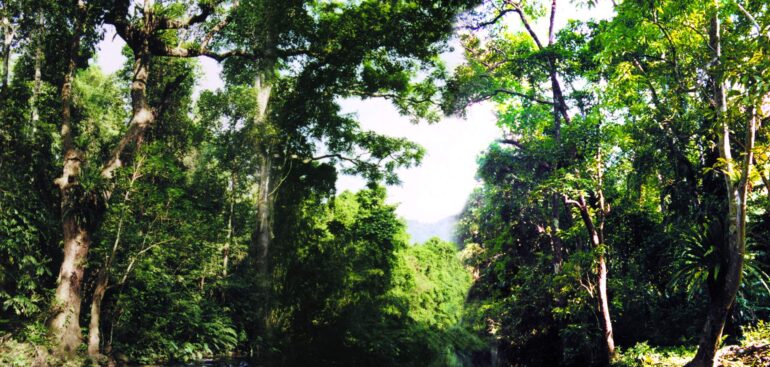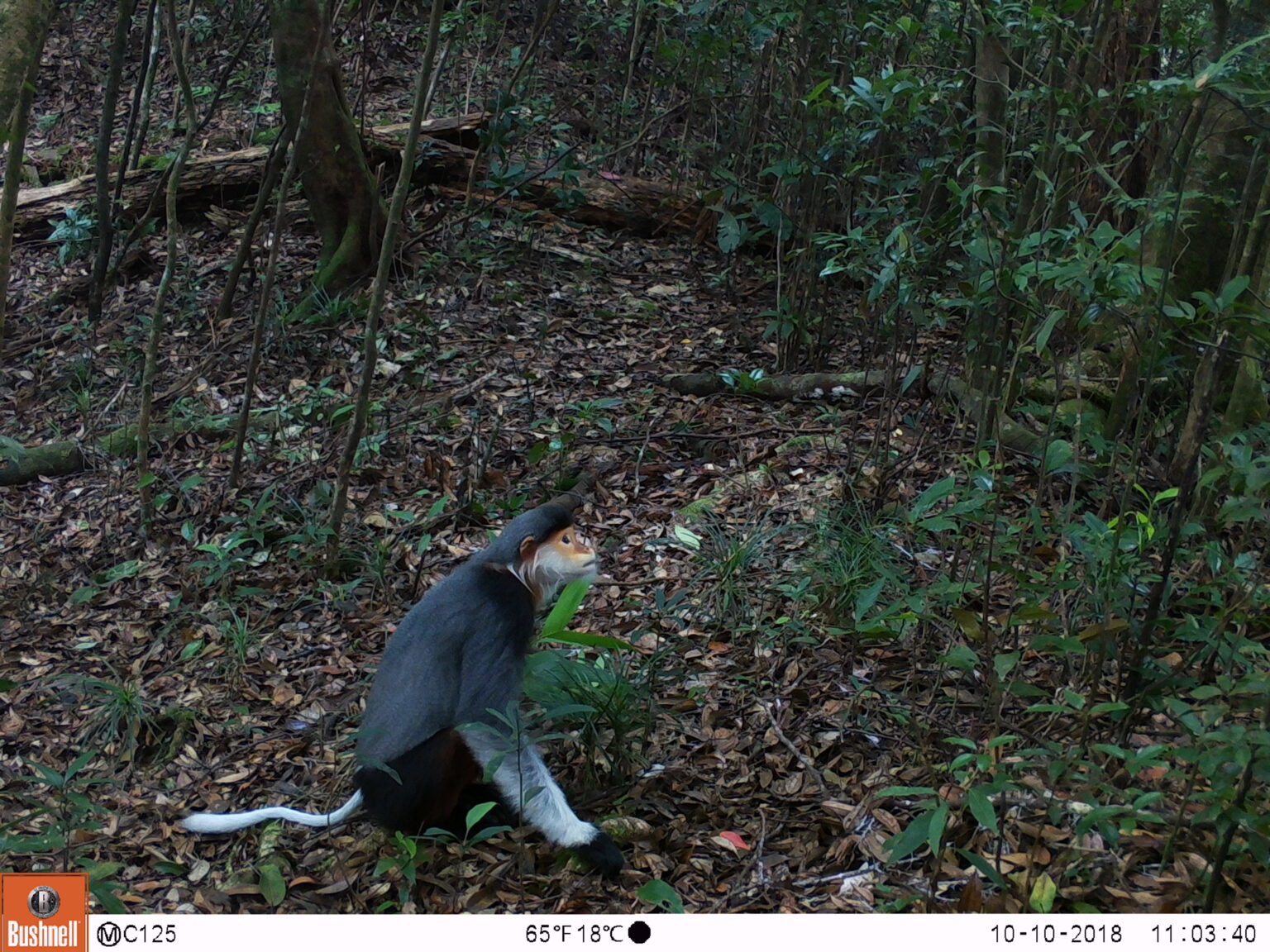
Forest and stream habitat in Pu Mat National Park (Nghe An) – Photo provided by the National Park
Pu Mat National Park is a special-use forest in the west of Nghe An province. In Thai, Pu Mat means high slopes. It was established under Decision No. 174/2001/QD-TTg of the Prime Minister dated November 8, 2001 on upgrading Pu Mat Nature Reserve to a National Park. Pu Mat National Park is currently identified as the core zone of the Western Nghe An Biosphere Reserve recognized by UNESCO in 2007.
Pu Mat National Park is located at 18 o 46′ North latitude and 104 o 24′ East longitude in Nghe An province. Pu Mat National Park is located on the administrative boundaries of 3 districts: Anh Son, Con Cuong, and Tuong Duong, the southern boundary of the National Park runs along the Vietnam-Laos border. Pu Mat National Park is located in the tropical monsoon climate zone. The average annual rainfall here is 1,800mm and the average temperature is 23.5 o C.
Located in the Central region, Pu Mat National Park has many advantages in tourism development: large area, high biodiversity with many species of forest animals and plants newly discovered in recent times: 2,500 species of plants belonging to 160 families and nearly 1,000 species of animals…
In particular, a wild natural landscape that has never been touched by human hands: Khe Thoi, Khe Bu, Khe Choang, Cao Veu upstream primeval forests… Khe Kem waterfall, Moc stream, Giang river, Sang Le forest and the typical cultural features of the Thai, H’mong, Dan Lai ethnic groups – wildness is a gift of nature bestowed on Pu Mat National Park.
Unique features
For scientists, the name Pu Mat is not strange because this is one of the first places to discover a rare animal: Sao la. With a core area of 94,804 hectares and a buffer zone of 86,000 hectares, spread over 3 districts of Tuong Duong, Con Cuong and Anh Son of Nghe An province, Pu Mat is home to the Thai people – an ethnic group that has lived here for many generations. The wild and majestic beauty of Pu Mat mountains and forests is mixed with the unique and sophisticated culture of the Thai people. They live in most villages, in wooden stilt houses with the profession of growing wet rice. In the hilly areas, they participate in growing trees or slash-and-burn farming, growing vegetables or other food crops; raising livestock and poultry; making traditional rattan and bamboo products and weaving. Thai brocade is famous for its uniqueness, colorful and durable colors. Keeping the long-standing tradition, the Thai people live together in clans, each community has its own beliefs and customs, and festivals associated with bumper crops and agricultural production. Bamboo dancing and drinking rice wine are unmistakable characteristics in the daily life of the Thai people. The minority are the Kinh people (mainly living in Con Cuong town) and the Dan Lai people. The Dan Lai people live in 3 villages: Co Phat, Ban Con and Ban Bung in Mon Son commune, located in the southeast of Pu Mat National Park. They live and cultivate on sloping land, making a living by hunting and gathering.
Priceless gifts of nature
In Thai, Pu means mountain peak, Pu Mat is the highest peak in the area (1,841m) and is the name of the National Park. Rarely any tourists conquer this peak even though they may have stood with their arms outstretched on the top of Fansipan before. Pu Mat is beautiful in the majesty of the green forest, in the pristine beauty untouched by human hands. Coming to Pu Mat, tourists will admire the wildness of the primeval forest with the highest biodiversity in Vietnam and many outstanding landscapes.

Red-shanked douc langur (Pygathrix nemaeus) – Photo provided by the National Park
Coming to Pu Mat, visitors will admire the pure casuarina forest about 40km from the park’s administrative area, about 100ha wide. This is an ancient forest, about 50m high and shady all year round, located in Tam Dinh commune, Tuong Duong district. The nature here is truly magical with green leaves still covered with dew drops every morning, the sound of birds chirping from branch to branch at dawn.
Enjoy the relaxation in the morning, visitors can immerse themselves in the cool nature of Khe Kem waterfall (also known as Kem waterfall) in the typical hot and humid sun of the Central region. About 20km south of Con Cuong town, Kem waterfall is majestic at an altitude of 150m. Many scientists when researching here have confirmed that Kem waterfall is the most pristine waterfall in Vietnam. The road to the waterfall is winding, curving and bumpy. Maybe that will discourage visitors, but for those who overcome the not-so-short journey to see with their own eyes a natural creation for Pu Mat, they will certainly not feel regretful. The Thai people call Kem waterfall Bo Bo, meaning white silk strip. Looking up from the foot of the waterfall, you will have the feeling that the stream flows endlessly in white foam strips, like an endless white silk strip. Blending in with that magical white color is a clear, cool stream with the singing of all kinds of birds.
On the way to Kem waterfall, the impression that remains in visitors about the beauty of Pu Mat is the sound of water flowing at Pha Lai dam (flower of heaven), in the red color like royal poinciana on the treetops on both banks of Giang river (about 20km from the administrative area of the national park). A strange and almost rare thing in Pu Mat is that on small boats cutting through the waves on Giang river, visitors seem to return to true nature, where humans are only a small part of nature. On both banks, the trees are dense, wild with the highlight being the majestic limestone mountains, dotted with the colorful colors of orchids and the cool, clear blue water. If visitors bring some fruits, they will surely meet the children and grandchildren of old Ton who are not afraid to “receive gifts”. They will swing on the tree branches, creating a scene like Hoa qua son.
From Khe Diem bridge intersection on Highway 7, going along the road to Mon Son, Luc Da area of Con Cuong district about 3km, visitors will encounter Moc stream. Unlike other streams, the water here seems to rise from the ground, clear and flowing, dispelling the scorching heat of summer. In autumn, the stream seems cooler with the weather. On the contrary, in winter, nature here gives the stream a miracle: the water is extremely warm on cold days.
Source: Department of Natural Resources and Environment



